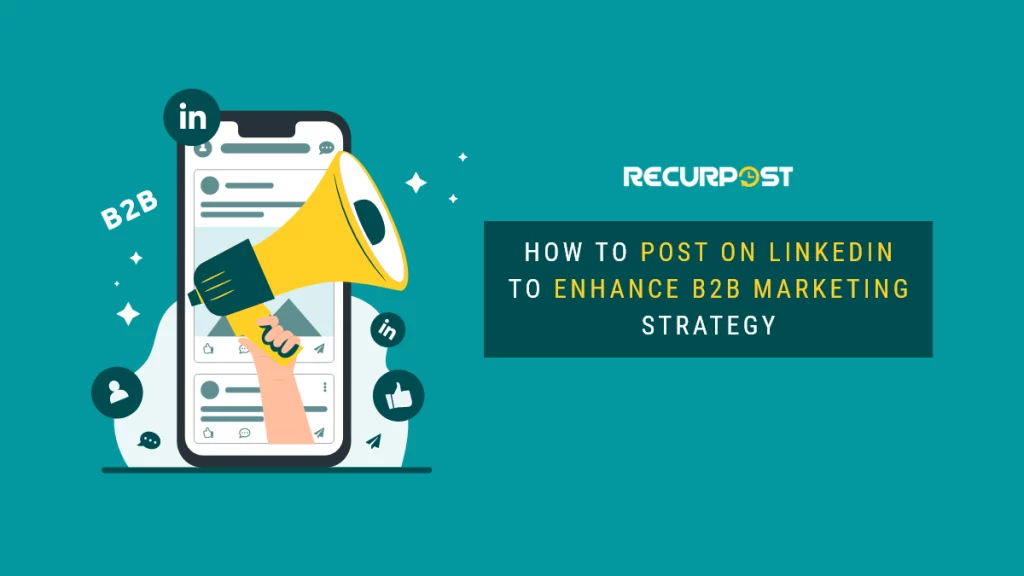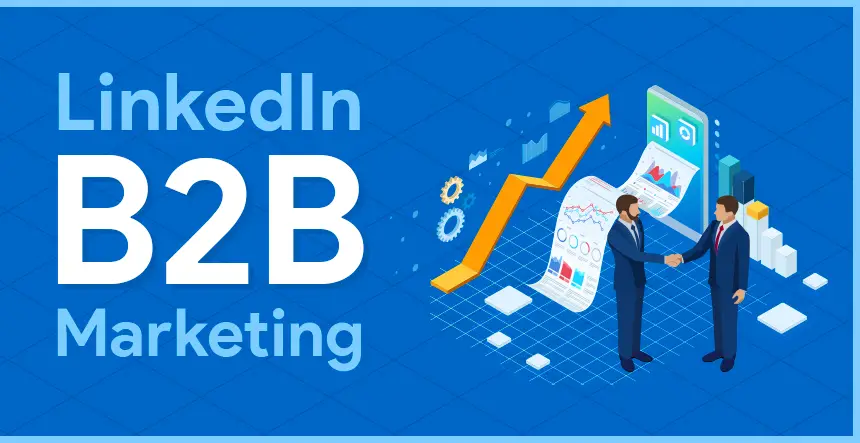I often earn from qualifying purchases. This includes Amazon Associates.
Welcome to the world of B2B LinkedIn marketing, where the possibilities are endless and the competition is fierce. As a small or medium-sized business owner, you may be wondering how to navigate this complex landscape and stand out from your competitors. With over 700 million users on LinkedIn, it’s no surprise that more businesses are turning to this platform for their marketing needs. But how can SMBs effectively leverage LinkedIn for maximum impact? In this comprehensive guide, we’ll explore proven strategies that will help you elevate your B2B marketing game in 2023 and beyond. So grab a cup of coffee and let’s dive into the world of B2B LinkedIn marketing!
Introduction to B2B LinkedIn Marketing
If you’re a small-to-medium business (SMB), you may be wondering how you can use LinkedIn for your business. After all, LinkedIn is a platform primarily used by professionals to network and find jobs. However, LinkedIn can also be a powerful marketing tool for SMBs. In this guide, we’ll show you how to effectively market your business on LinkedIn.
First, let’s go over some basics. LinkedIn is a social network for professionals. This means that most of the users on the platform are there to network and build their careers. Because of this, LinkedIn has a different tone than other social networks like Facebook and Twitter. It’s important to remember this when creating your content strategy.
When marketing on LinkedIn, it’s important to focus on quality over quantity. Your content should be informative and helpful, rather than promotional or salesy. If you provide value to your target audience, they’re more likely to engage with your brand and consider doing business with you in the future.
To reach your target audience on LinkedIn, you’ll need to create a Company Page for your business. This is separate from your personal profile and will allow you to share updates about your company, product news, job openings, and more. You can also use your Company Page to run ads targeting LinkedIn users.
In addition to creating quality content, another effective way to market your SMB on LinkedIn is through employee advocacy. Employee advocacy is when employees share company content on their personal profiles. This can help you reach a larger audience, as employees often have more followers than your Company Page.
Finally, LinkedIn also offers several tools that can help you better target and measure your campaigns. For example, LinkedIn Ads Manager allows you to create targeted ad campaigns and track the results in real-time. You can also use LinkedIn Insights to gain valuable insights into your target audience and better understand their needs.
By following these best practices, you can effectively market your SMB on LinkedIn and reach a larger audience of potential customers.
Identifying Your Target Audience and Establishing a Social Media Presence
As a small to medium sized business, it is essential that you first identify your target audience before establishing a social media presence. By understanding who your target audience is, you can then better craft content and messages that will resonate with them.
To help you get started, ask yourself the following questions:
- Who are my potential customers?
- What needs or wants do they have that my product or service can address?
- What are their demographics? (Age, gender, location, etc.)
- What interests do they have?
- How do they like to consume content? (Text, video, audio, etc.)
Once you have a good understanding of your target audience, you can then start to establish a social media presence that will reach them where they are. The most popular social media platforms for businesses are LinkedIn, Facebook, and Twitter. Decide which platform(s) make the most sense for your business and start creating engaging content that speaks to your target audience.


Creating Engaging Content that Drives Results
As a small or medium business (SMB), it can be tough to create content that breaks through the noise and speaks to your target audience. But if you want to use LinkedIn effectively for marketing, you need to do just that.
Here are some tips for creating engaging content that will help you drive results on LinkedIn:
- Know your audience. Before you start creating any content, it’s important that you take the time to understand who your target audience is. What are their pain points? What kinds of content are they already engaging with? Once you have a good understanding of your audience, you’ll be better equipped to create content that resonates with them.
- Make it visual. People are more likely to engage with visuals than text alone, so make sure your content includes plenty of images, infographics, and videos.
- Keep it short and sweet. In today’s attention-deficit world, people don’t want to read lengthy pieces of content. Keep your posts short and to the point – people will appreciate it!
- Use calls to action. Encourage your readers to take action by including calls to action in your posts. For example, you could invite them to download a white paper or sign up for a webinar.
- Promote your content elsewhere. In addition to promoting your content on LinkedIn, make sure you’re also sharing it on other channels like Twitter, Facebook, and your blog
Leveraging Paid Ads to Reach Your Target Market
There are a number of different paid ad options available on LinkedIn, each with its own set of targeting options. By leveraging the targeting options available, you can reach your target market with LinkedIn paid ads.
One option is Sponsored InMail, which allows you to send messages directly to members of your target audience. With Sponsored InMail, you can target by job title, company size, or other factors.
Another paid ad option is Sponsored Content. This allows you to place your content in front of members of your target audience who are not currently following your company page. You can target by job title, company size, or other factors.
LinkedIn offers Text Ads, which are small ads that appear in the right-hand column of the LinkedIn homepage and member’s profile pages. Text Ads allow you to target by job title, skillset, or other factors.
Repurposing Your Existing Content
If you’re like most small businesses, you have a wealth of content that you’ve created over the years. And while it may be tempting to let this content languish on your website or blog, there are actually quite a few ways that you can repurpose it for your LinkedIn marketing efforts.
One way to repurpose your content is to create a LinkedIn group around a particular topic. This gives you a great opportunity to share your existing content with a new audience, and to get feedback and ideas from other members of the group.
Another way to repurpose your content is to create an eBook or white paper from it. This can be an especially effective way to generate leads, as people who download your eBook or white paper are typically interested in learning more about your products or services.
You can also simply post links to your existing content on LinkedIn. This is a great way to drive traffic back to your website or blog, and it also allows people in your network to easily access and share your content.
Using LinkedIn Groups to Connect with Prospects
If you’re not using LinkedIn groups to connect with prospects, you’re missing out on a valuable opportunity. LinkedIn groups offer a great way to connect with potential customers and build relationships.
When you join a LinkedIn group, you become part of a community of like-minded professionals. This gives you the chance to build relationships and connect with potential customers.
To find relevant groups, start by searching for keywords related to your industry or business. Then, take some time to read through the group descriptions to find ones that are a good fit for your business.
Once you’ve joined a few groups, start participating in the discussions. Share your insights and expertise, and be sure to include a link to your website or blog in your signature. By providing value and building relationships, you’ll soon start to see results in the form of increased web traffic and leads.
Measuring and Analyzing Your Results
As a small or medium business, you can’t afford to waste time and money on marketing strategies that don’t work. That’s why it’s important to measure and analyze your results so you can fine-tune your approach and make sure you’re getting the most bang for your buck.
There are a few key metrics you should track when evaluating your LinkedIn marketing efforts:
Engagement: How often are people interacting with your content? Do they like, comment, and share your posts?
Reach: How many people are seeing your content? LinkedIn offers insights on both organic and paid reach.
Leads: How many leads are you generating from LinkedIn? You can track this by looking at how many people fill out contact forms or click through to your website from LinkedIn.
Sales: How much revenue is coming in as a result of your LinkedIn marketing? This is the ultimate metric that will show you whether or not your efforts are paying off.
To get started, login to LinkedIn and go to the ‘Campaign Manager’ tab. From there, select the ‘Insights’ tab to see detailed analytics for all of your LinkedIn campaigns. Once you have a good understanding of how each campaign is performing, you can start making changes to improve results.
Conclusion
In conclusion, LinkedIn is an incredibly powerful platform for SMBs to use in their B2B marketing efforts. The above strategies can help you take your business’s presence on the platform to the next level and reach a wider audience of potential customers. Don’t be afraid to experiment with different tactics and adjust your strategy as needed; with a little bit of trial-and-error, you should eventually find success on LinkedIn!
Amazon and the Amazon logo are trademarks of Amazon.com, Inc, or its affiliates.






